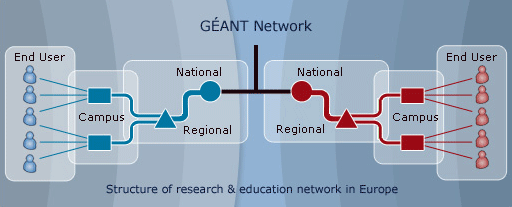Research & Education Networks
One of the key strengths of the European Research and Education (R&E) system is the ability of researchers to collaborate across the community on a huge range of different projects. This collaboration helps bridge the digital divide and maximise the value of R&E in Europe.
Research networks are an essential part of many research and education activities. These networks provide the data communications connectivity needed to allow researchers and academics to collaborate together in their work – breaking down the barriers of distance.
Research and education networking in Europe is organised in a hierarchical fashion, connecting research and education community users. The network connection between two end users will be provided by a chain of several networks, each connected to the next. This chain will typically start with a campus network, then may include a regional network before connecting to a national (NREN) network. Then to the pan-European backbone GÉANT, from there to another NREN and so on back down the chain to the user at the other end.
|
Making sure that all these different networks and technologies can work together is a complex task and so the work GÉANT undertakes on developing standards and policies is vital. Providing the backbone network which interconnects these national systems is a core element to the work of GÉANT. Much of the GÉANT Research Programme is directed at addressing the issues of this multi-domain environment, to ensure seamless, end-to-end provision of services wherever users are. Through its research programme and organisational model, GÉANT offers core advantages over alternative, commercial providers including:
The GÉANT network is fundamental to the EU's vision of a European Research Area, enabling academic collaboration across Europe and serving to reduce the digital divide of research and academic networking. |

 Illustration of a cross-domain supply chain of data communications
Illustration of a cross-domain supply chain of data communications
